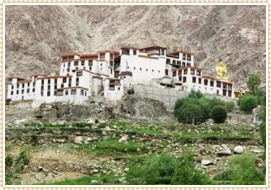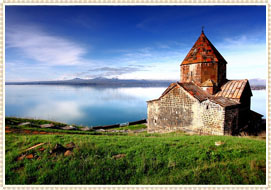
While in remotest of Ladakh, a tourist cannot miss the enlightening tryst with Buddhist heritage present with a tour to Alchi. Standing on the pristine backdrop of Ladakhi mountains, this is nothing but a quaint 1,000 year old monastic village dedicated to the Buddhist revivalist era that originated from Tibet.
Located in the lower highlands of Ladakh, this religious enclave is ruled by Alchi Monastery or Chhoskhor Temple Complex amassing five different temples, chortens and monasteries dedicated to different time frames. From outside, the complex might give a rather cold and uninterested feeling, but from within the temple murals are seen as the resplendent attraction of Ladakh’s Indo-Tibetan art.
Inside the monastery complex, one can find truly unique and amazing specimens of ancient wall murals, wooden sculpture in its mud-walled temples. The murals here are accredited as the finest surviving example of Buddhist revival art or the religion’s second spreading that took place in Tibet in late 10th century.
Also, Alchi tour passes through is one of the few monastic towns that have survived the Islamic depredations of the fourteenth century, due to its least accessible location.
The oldest and the largest monastic assembly hall at Alchi complex, Du-Khang was built in the late eleventh century and features a meditating image of Vairochana, the ‘Buddha Resplendent’, bordered by four other manifestations of Buddha appearing inside the temple. This part of Alchi monastery is still the core of all activities. Here, the monks conduct ceremonies and daily rituals. The retained ancient structure, inclusive of the original wooden door frame is the undisputed wealth of the complex. The later additions to the heritage of this monastic structure came in during the 12th and 13th centuries with the inclusions of the colonnaded veranda and frescoes of one thousand Buddhas. The greatest treasures of Alchi also include six elaborate mandalas painted on the walls.
The Sumtsek, located left to the Du-khang, marks the high watermark of medieval Buddhist art. Built 900 years ago, the temple still looks as fresh and vibrant as it was then. This three storey temple structure here features the colossal structures of Avalokitesvara, Manjushri and Maitreya, in alcoves of its walls.
LocationAlchi is located on Srinagar Leh highway and is 70 km away from Leh, the capital of Ladakh.
Alchi Tourist Attractions

Alchi Tour attractions revolve around five temples inside the single monastic complex. The first in the series is Sumtsek, the three tiered temple. The wooden porch that leads the sanctum of the temple is carved in an Indian Gandhara art style. The carvings of renown here include three figures of Buddha inside a tri-lobed frame and murals here cover the three levels with hundreds of little Buddhas.
Du-khang, the oldest structure at Alchi is renowned for its huge main assembly hall adorned with many murals, paintings, variety of mandalas, sculpture of four headed Buddha and of various goddesses. Next in the series, Vairocana Temple is admired for its mandalas and antique murals. The Lotsa Temple here features Lotsava Ringchen Zangpo as the slightly reptilian figure to the left behind the central Buddha cabinet. The last temple, Manjushri preserves the colourful four sided statue of Buddha of wisdom, Manjushri.
How to reach in Alchi LadakhAir - Nearest airport is in Leh, at a distance of 70 km, and connected to all major cities of India.
Rail - Depending on the railways is not the best option for Ladakh visit. The Jammu station is far from the main city, Leh, from where to commute is easier than from Alchi Tour.
Road - There are good, exciting roads. Alchi is nearly 540 km from Manali, of Himachal Pradesh and 364 Km from Srinagar, the capital of Jammu and Kashmir.